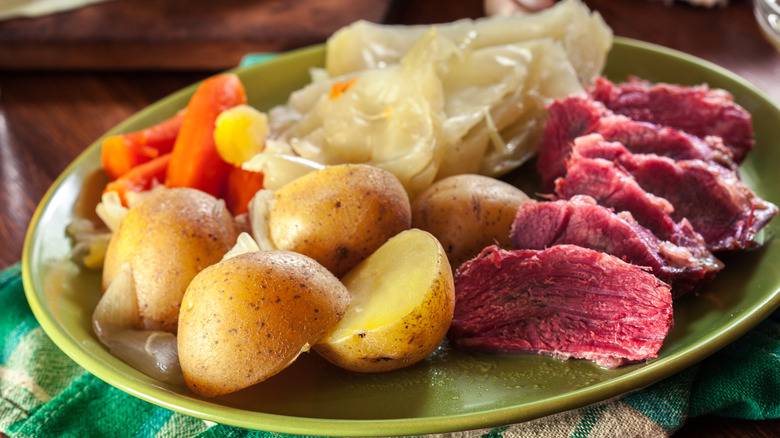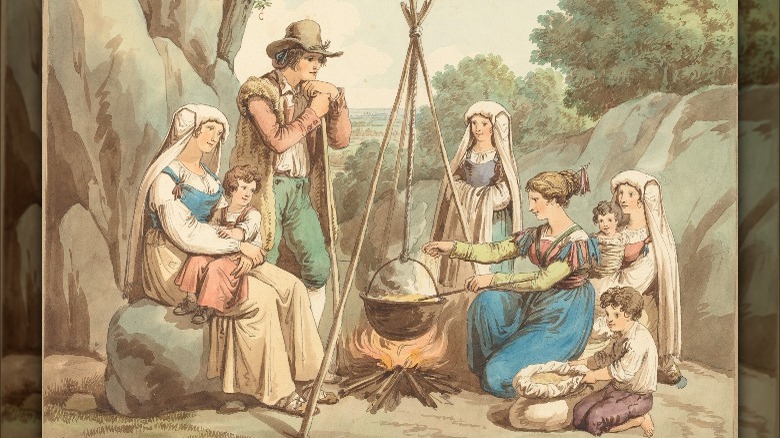The Hearty Ingredients That Make Up A New England Boiled Dinner
New England has longtime been a hub for culinary prowess. Today, we're deep-diving into one of the most humble, understated dishes in the American culinary oeuvre — a dish New England calls "the plainest, squarest, clunkiest, and most wonderful meat and potatoes meal in America." Introducing: a New England boiled dinner.
The star of the show is corned beef brisket, slow-stewed until fall-apart tender and cut into large chunks or thick slices. This salty, savory centerpiece is flanked by tender stewed vegetables, typically beets, steamed cabbage wedges, boiled potatoes, and rutabagas. You can also use turnips, carrots, squash, Brussels sprouts, or onions — whatever crop fared the best this season on your subsistence farming plot.
The resulting plate looks like if you dyed a shirt and then washed it and most of the dye came out. Its faded, muted colors might not be much to look at, but New England boiled dinner is the ultimate comfort food. All the juices intermingle into a fragrant, hearty, stick-to-your-ribs meal perfect for weathering cold New England winters — which was exactly the motivation behind the dish's invention.
A meal to fuel the masses
Utensils weren't really a big thing for 17th-century colonists living in New England — especially not forks. Mostly, foodies ate with their hands or else used spoons. In fact, this dining trend was so common that many New England recipes incorporated meat that was so heavily stewed that it could be scooped up with a spoon, earning it the fitting moniker "spoon meat." New England boiled dinner is one such dish.
The colonists were a busy crew tasked with literally building a country from the ground up. As such, New England boiled dinner was crafted with utility in mind. It can be made in a single pot over the fire — which would have been burning to heat the home anyway. As the fire burned, it slow-cooked the dinner as colonists went about their daily chores. By the time they'd finished, dinner would be ready. Some colonists even prepared the boiled dinner the previous night before going to bed and let it boil all through the night until noon the next day.
Specifically, the dish is thought to have originated in Boston in the kitchens of Irish immigrants, which might be part of the reason why the corned beef meal has emerged as a festive St. Patrick's Day staple today.
How a New England boiled dinner is prepared
New England boiled dinner might not be glamorous, but it remains popular with rural New Englanders as a budget-friendly comfort food. As New England puts it, "You could not get more generic, prosaic, or neutral unless you called it 'Dinner, Boiled.'"
To make it, the only cooking skill required is boiling a pot of water. Though, admittedly, New England boiled dinner takes roughly six hours to prepare, so it's not an ideal dish for last-minute dinner on a busy weeknight. But, you can make it ahead in a slow cooker and walk away as it assembles. The vegetables are boiled in the meat's cooking liquid for a salty and flavorful bite. You can either cook it all together as a one-pot meal or, if you have some extra time on your hands, boil the meat and vegetables separately to cater to their individual unique cooking times.
Today, New England boiled dinner enjoys an especially popular fanbase in Vermont and has inspired a few regional variations. Communities closer to the shoreline often used cod instead of corned beef. Other folks use rump roast or add salt pork into the mix. However you choose to do it, serve your New England boiled dinner with a side of horseradish sauce and a glass of cider.


